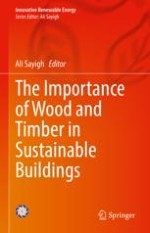2022 | OriginalPaper | Chapter
8. Multiple Scales Insight into Using Timber for a Sustainable and Future Approach to Buildings
Author : Carolina Ganem Karlen
Published in: The Importance of Wood and Timber in Sustainable Buildings
Publisher: Springer International Publishing
Activate our intelligent search to find suitable subject content or patents.
Select sections of text to find matching patents with Artificial Intelligence. powered by
Select sections of text to find additional relevant content using AI-assisted search. powered by
